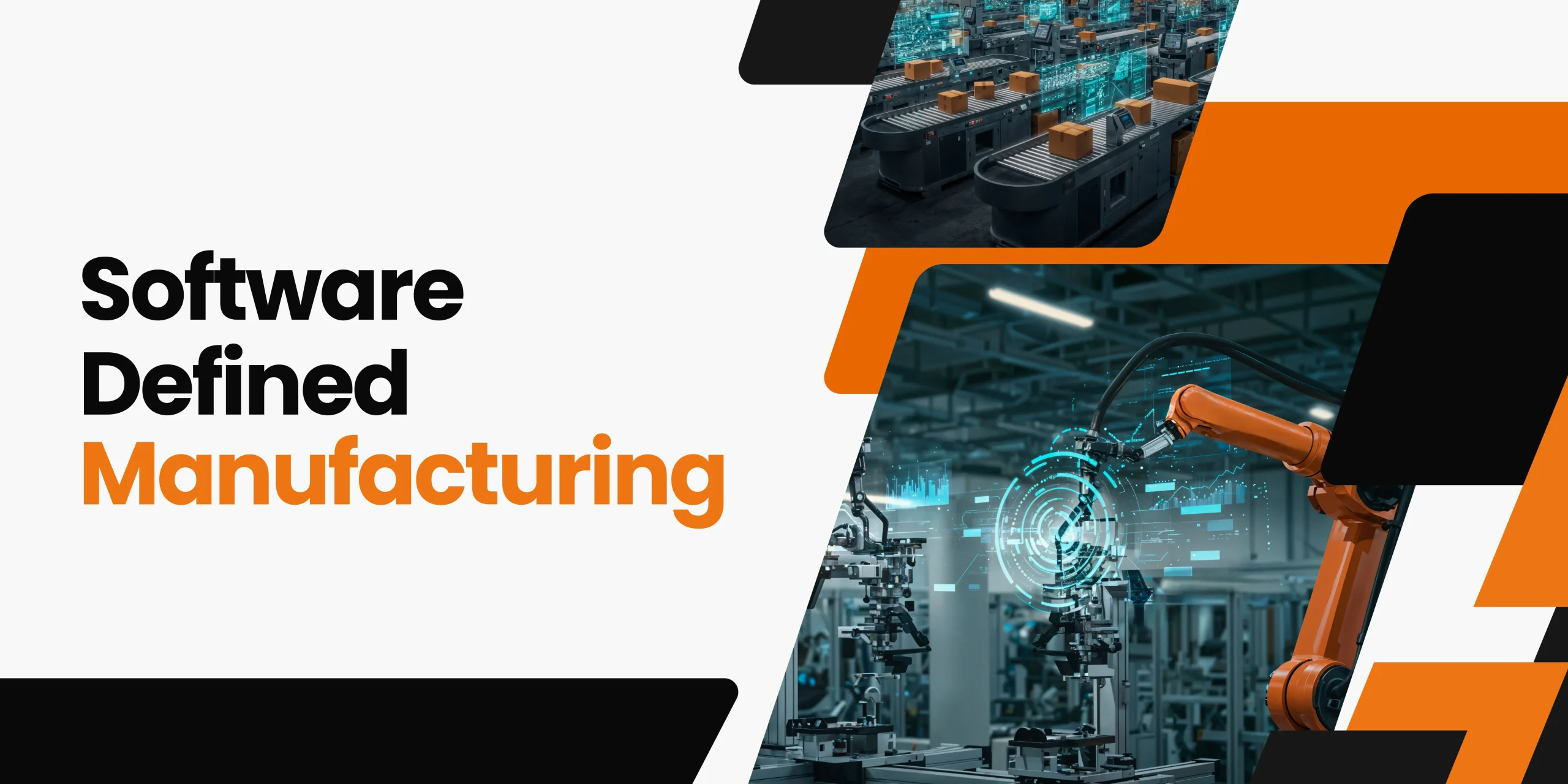September 1st, 2025
Category: Manufacturing
No Comments
Posted by: Team TA

Manufacturing is embracing digital transformation at an astounding rate. To overcome challenges and gain a competitive advantage, 80% of CEOs are increasing their investments in digital technologies, according to Gartner. Modernizing operational technology (OT) and integrating it with information technology (IT) through analytics, IoT, and artificial intelligence (AI) are vital for successful implementation in factories. Software-Defined Manufacturing (SDM) offers a comprehensive solution that enables enterprise-wide agility, enhances quality, and fosters creative, data-driven revenue streams by streamlining hardware, connectivity, security, and data across facilities and supply chains.
What is SDM? Why is it essential for the factories of the future?
By separating manufacturing intelligence from physical machinery, Software-Defined Manufacturing (SDM) is a groundbreaking technique that enables design and operational improvements without replacing current machinery. SDM improves a factory’s agility, flexibility, and adaptability by integrating data, systems, and workforce using dynamic software.
SDM becomes essential as the industry moves toward smart factories, as it speeds up innovation and facilitates smooth operation integration. It is a fundamental component of the factories of the future because it offers effective control and sets manufacturers in a position to be competitive, scalable, and ready for the changing environment of Industry 5.0.
What are the key advantages of Software Defined Manufacturing ?
Software-Specific Manufacturing uses virtualization to transform production. This saves manufacturers time, money, and resources by allowing them to test concepts and model results before implementing physical changes. Its benefits can be grouped into three major value levers:
-
- Scientific root cause analysis: SDM uses precise, data-driven diagnostics in place of traditional trial-and-error techniques. This also utilizes first-principle insights instead of the traditional interrogation method to identify issues at their source.
- Enterprise knowledge integration: SDM transforms dispersed data into useful intelligence by integrating machine data and human expertise. In comparison to conventional spreadsheets or disjointed tools, this produces a centralized knowledge layer that is far more dynamic and accessible.
- Intelligent orchestration: SDM allows factories to self-learn, adapt, and optimize operations by coordinating human workers, cobots, robotics, and AI-driven decision systems seamlessly. Production networks gain scalability, resilience, and agility from this real-time orchestration.
What challenges must manufacturers address to modernize for Software-Defined Manufacturing?
Outdated networks, non-standard hardware, unclear IT/OT isolation, legacy endpoints that aren’t internet-ready, brittle cable-only links, and coverage black spots are all issues that manufacturers face. Increased cyber risk, fragmented data, and unintegrated IT/OT are all factors. Costs, labor shortages, and technology debt limit a company’s ability to scale beyond a single site. For resilient, scalable factories, a comprehensive SDM approach unifies operations, secures data flows, and standardizes infrastructure.
What is the potential for expansion of the new technologies presently being used in manufacturing?
AI, IoT, and advanced analytics are some of the emerging technologies that are propelling modernization efforts and smart factory initiatives. Manufacturers need to make sure the data is clean, integrated, and adoption-ready to realize this value. These developments are essential to the transformation of Industry 5.0 and long-term expansion of the manufacturing sector because they increase productivity, flexibility, and competitiveness.
How can manufacturers integrate the right tools to achieve a true Software Defined Factory (SDF)?
Although dashboards, real-time controls, and frontline processes all have strong tools, utilizing them alone does not fulfill SDF’s mission. The key is smooth integration, which allows people to quickly update controls and modify solutions as operations change. To create a single, future-proof tech stack that promotes agility, scalability, and ongoing innovation throughout the factory floor, top manufacturers are embracing open ecosystems that connect legacy and contemporary technologies through cooperative, partner-driven platforms and open data models.
In what ways does Software-Defined Manufacturing (SDM) enhance supply-chain resilience, cost efficiency, and sustainability?
SDM combines flexible automation and software orchestration to improve the responsiveness of supply networks and factories. It facilitates localized production, supplier diversification, and quick line reconfiguration, which lowers inventory and transportation distance. By optimizing scheduling, routing, and asset utilization, real-time data reduces expenses and emissions.
While SDM does not remove raw-material constraints, it does de-risk supply chains, increase sustainability, and improve product quality. It also increases operational tolerances and automates adaptive responses to disruptions.
What are the core pillars and leadership actions needed for a successful SDM transformation?
SDM is built on two main principles:
-
-
- Engineering-led Design: This enables the development of adaptable products and recognizes that significant upfront investments in automation eventually result in higher productivity and higher profits.
- Leadership and Collaboration: Strong executive backing and cross-departmental leaders who involve all stakeholders and match investments with business strategy are necessary for success.
-
Prioritize high-impact projects that can be carried out regularly, concentrate on developing critical capabilities, and make sure systems are integrated across operations to modernize effectively.
Finally, put a people-centered approach first by upskilling staff, making use of current knowledge, and striking a balance between workforce readiness and the rollout of new technologies. This guarantees a seamless and long-lasting switch to SDM.
Final Thoughts
It takes more than just technology to integrate engineering, IT, and operational technology (OT) in manufacturing; it also requires new collaborations, organizational transformation, and coherent procedures. The business must not only give employees simpler tools, but also reconsider how it sets up, runs, and maintains its systems. Dismantling organizational silos and guaranteeing the long-term adoption of Software Defined Manufacturing (SDM) requires strong executive support and cross-functional leadership.
The SDM process produces resilient, flexible factories with increased throughput, reduced costs, enhanced eco-efficiency, and quicker response to demand, despite its complexity. SDM improves employee experience and future-proofs operations by bringing people, data, and automation together. Take small, practical steps to unlock long-term value and a more sustainable manufacturing future.